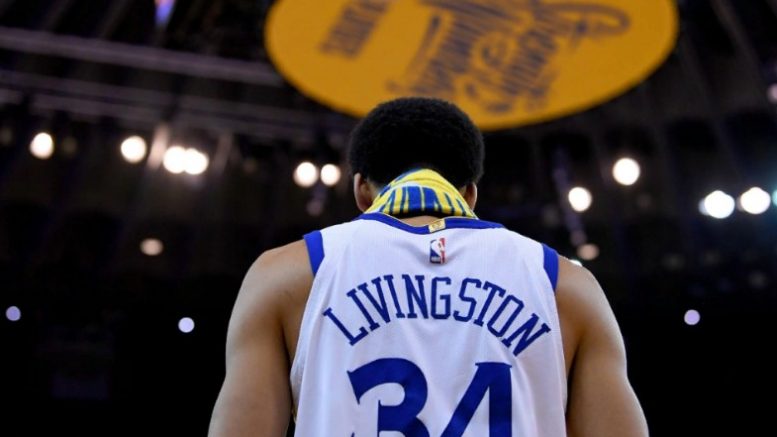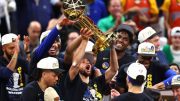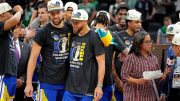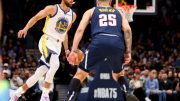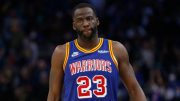Shaun Livingston’s career appeared to be doomed to injury until a late-career surge cemented his place on the all-time team.
If you asked someone about Shaun Livingston in 2013, they would have undoubtedly winced and cited his terrible knee injury.
NBA fans know all too well how injuries can end a player’s career, and it looked like another sad story was about to happen with the high school player who had been compared to Magic Johnson.
Livingston is best known for being a part of one of the best teams ever made, the Golden State Warriors of the mid-2010s.
He reinvented himself as a player, and as a result, he became one of my favorites to watch. Backup point guards have always piqued my interest because they are one of the most difficult positions to fill in any basketball game, let alone in the finest league on the planet. It’s like attempting to get into the passenger seat of a moving automobile while driving.
Livingston was unique in that he could check in, quickly figure out the game’s flow, and find a way to make an effect.
Few players in the NBA could do what he did, and his size and defensive versatility allowed him to play with and without Steph Curry, which helped the Golden State Warriors launch a dynasty in 2015.
How did Shaun Livingston end up in this situation?
Shaun Livingston was the fourth overall choice in the 2004 NBA Draft, coming out of high school and signing with the struggling Los Angeles Clippers. He was still striving to establish himself as an elite guard in the league at this stage, but his size and quickness had shown promise.
The injury I’m referring to occurred during his third season with the Clippers, when he tore his ACL, PCL, and meniscus, as well as dislocating his left knee cap and fracturing his left leg in an awful fall. I would advise anyone who hasn’t seen the video to refrain from doing so.
Shaun Livingston traveled all over the country after his knee injury, looking for a permanent home. Before joining the Brooklyn Nets for the 2013–14 season, he played for Miami, Oklahoma City, Washington, Charlotte, Milwaukee, and Cleveland.
He joined the “title-contending” Nets, which included Kevin Garnett and Paul Pierce, as well as All-Stars Joe Johnson, Deron Williams, Brook Lopez, and Andrei Kirilenko. We’re all aware of how the story ended. While it may have worked well in 2K, they were only able to win one series against the Toronto Raptors in the playoffs.
Williams, who was in his 29th season, was starting to fade, which gave his new backup, Shaun Livingston, more playing time. Shaun was able to play 76 games this season, starting 54 of them, which was a silver lining amidst the failures and aging stars.
He averaged 8.3 points and 3.2 assists per game while shooting 48 percent from the field, a career high at the time.
The Golden State Warriors, on the other hand, were in desperate need of a backup point guard. And when I say thirsty, I mean it.
The Warriors understood they needed to address the position in the offseason after cycling through sub-par choices like Steve Blake, Jordan Crawford, Toney Douglas, and Nemanja Nedovic (remember him?).
(As an aside, I recall Golden State trading for Crawford just before the deadline.) He was averaging 13.7 points in 39 games for the Boston Celtics at the time, and he appeared to be a solid player for a tanking club. It didn’t work out, and he ended up spending the next two seasons in China.
Livingston was one of Brooklyn’s best players, but because Mikhail Prokhorov was paying top dollar for a “title contender,” the Nets were above the salary apron, which meant that if another team came along and offered him more than the taxpayer mid-level exception, Brooklyn would be unable to compete.
In order for the deal to go through, Golden State offered him the full mid-level exception, which is about $6 million more than Brooklyn could afford.
Immediate effect
We all know how the Warriors’ season ended, but the first major impact was on Stephen Curry. He had just made his first All-Star appearance at the time, but Mark Jackson’s pick-and-roll system had forced him to do a lot for a full season, and the team was struggling in the playoffs.
When he sat, however, the offense crumbled.
When compared to his first MVP and championship seasons, Steph’s minute burden dropped from 36.5 to 32.7, despite no productivity decline. In fact, he improved his efficiency.
In this Golden State equation, there were other things that changed, but Livingston’s contribution can’t be overlooked. Andre Iguodala moved to the bench, Draymond Green rose, and Steve Kerr joined the team.
When Steph rested, the Warriors knew we wouldn’t all be looking at our watches, waiting for him to return; Shaun was going to hold down the fort.
Like Steph’s fiery shooting, his size for the position made him an exception. If you were a point guard on the other team, you’d have to be concerned about Curry’s 3-point shot as soon as he crossed the halfcourt line. Shaun would sub in and take you down to the low block even if you were able to cover Steph and keep him quiet.
In the halfcourt or transition, his mid-range pull-ups (the pull-up jimbo, if you will) were unguardable, and if you were average-sized for your position, Livingston would just post you up and take a nice post-fade over you. Death, taxes, and Shaun Livingston’s post-fade are the only three certainties in life.
I once played a drinking game with him in which we drank a shot every time he made one of his famous middies. On Monday, I didn’t show up to work.
He was quick enough to check opposing guards on defense, but his stature suited Kerr’s switching approach brilliantly.
He was tall and strong enough to hold his own against big men, and because he was bigger than certain wings, the Warriors didn’t lose any ground in those battles. When you add in Iguodala and Draymond, there are basically no weak links on that end.
He may also play the one next to Klay Thompson or the two next to Steph Curry because of his versatility. The bench rotations were kept reasonably consistent until either player was in foul trouble or Kerr wanted to counter a certain matchup.
Livingston’s role in the playoffs stayed the same, and he actually shot better in the postseason than he did during the regular season. After everything he’d been through, I don’t know anyone who wasn’t delighted to see him win his first NBA championship.
Steph improved his game again the next season, winning the first-ever unanimous MVP and leading the league in scoring with nearly 30 points per game. This season, he played even fewer minutes, and the Warriors were frequently winning by such large margins that he rested most of the fourth quarters.
Shaun Livingston increased his minute load, points per game, and field goal percentage by roughly four percentage points. In Golden State, his function was so well-defined that it was ideal.
I adore the backup point guard position, and my favorite team had just signed the league’s top backup point guard. S.Dot might come in and play at his own pace, or even make an impact by finding his own shot. He accomplished it for a Warriors club that went on to win 73 games, the most in the NBA.
Livingston was the best at what he did, and 73 isn’t feasible without elite quality across the entire squad.
David West appears in Twilight Dubs
Things were going to change after signing Kevin Durant in the 2016 offseason, just days after losing the NBA Finals to the Cleveland Cavaliers.
The Warriors used to beat you with depth and variety, relying on their strength-in-numbers motto to win games. Following the signing of KD, the Warriors were forced to give up some of their depth and rely on cheap, ring-chasing veterans to round out their team.
Livingston, who was vital to their success on both ends, was a carryover from the previous squad and had to reinvent himself. It would be a lot easier this time.
Steve Kerr preferred to have two of his best players on the court at all times. Usually, it was Steph and KD, or Draymond and Klay. Those four began and finished halves, but Kerr had to find a mix of role players to fill up the gaps when they weren’t available.
It was a lot easier with one of the league’s most flexible backups.
Shaun could play alongside Steph or Klay, and it wasn’t difficult for him to fit in with Durant, who could score no matter who was on the court with him. He also worked well alongside Draymond, as the two of them wreaked havoc on opposition offenses.
Luke Walton, as an assistant coach, was often effusive in his admiration of the Warriors’ bench. There was a point in history when Livingston and Walton shared the court and formed a rather potent bench combination.
In a segment on ESPN, Zach Lowe talked about Livingston’s unusual bench combinations. They became a part of his time in Golden State.
Despite the presence of huge names and high-scoring scorers like KD, Steph, and Klay, Shaun did what he does best, and the bench unit was outstanding.
In 2016-17, Iguodala and Livingston combined for an astounding plus-10.2 in over 700 minutes, while he and David West combined for a plus-6.1 in just under 600 minutes.
Despite just Livingston and Iggy earning more than the minimum pay, the Warriors had the fifth-most effective bench in the NBA, according to Hoops Stats.
In the twilight of their careers, David West was the ideal foil for Livingston. Both had been playing for almost a decade and had found their niche as seasoned veterans who outsmarted and out-shot their opponents with airy, precise jumpers.
They knew just where to cut to have an open look at the rim if you wanted to assist them with either of their post-ups. West was one of the top mid-range shooters in the league and provided an easy outlet if Shaun was attracting attention in the post and the cut was covered.
While anchoring the Dubs bench with D.West, Shaun won two more championships, and by the time he was done, he wasn’t the guy with the horrible knee injury; he was an exceptional backup on some of the best teams to ever exist. And it was a lot of fun to watch.
The Official Whiteboard:
Subscribe to the NBA’s daily email newsletter by filling out the form below.
More thoughts may be found in our NBA at 75 series, and you can subscribe to The Whiteboard to stay up to date on all the latest NBA news and analysis.

